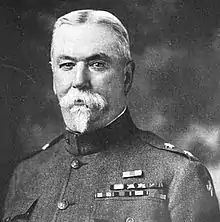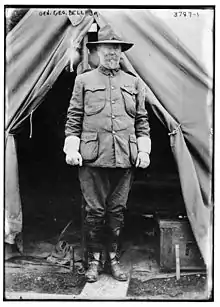George Bell Jr.
George Bell Jr. (January 22, 1859 – October 29, 1926) was a United States Army Major General. He commanded the 33rd Infantry Division during World War I and also commanded the United States VI Corps.
George Bell Jr. | |
|---|---|
 General Bell as commander of the 33rd Division | |
| Nickname(s) | Do It Now[1][2] |
| Born | January 22, 1859 Baltimore, Maryland |
| Died | October 29, 1926 (aged 67) Chicago, Illinois |
| Place of burial | |
| Allegiance | |
| Service/ | |
| Years of service | 1880–1923 |
| Rank | |
| Commands held | 16th Infantry Regiment El Paso District 33rd Infantry Division VI Corps |
| Battles/wars | American Indian Wars Spanish–American War Philippine Insurrection Pancho Villa Expedition World War I |
| Awards | Distinguished Service Medal (U.S. Army) Legion of Honor Croix de Guerre |
| Relations | Brigadier General George Bell (1828–1907) (Father)[3] Robert Ransom Jr. (Father in law)[4] |
| Other work | President, Hill State Bank, Chicago |

Early life and start of military career
Born at Fort McHenry in Baltimore, Maryland and the son of Brigadier General George Bell (1828–1907), he attended the United States Military Academy.[5] After graduating in 1880 he was posted to assignments throughout the country, including Fort Maginnis, Fort Shaw, Fort Ellis, Fort Snelling, and Fort Missoula. In the 1890s he served as Professor of Military Science at Cornell University. In 1894 he received a law degree from Cornell and passed the New York bar exam.[6][7]
Later career
He served in the Spanish–American War's Santiago Campaign and the Samar Campaign of the Philippine Insurrection. In 1907 Bell was appointed to the Infantry Equipment Board, taking part in the design of many items that were later used in World War I.[8]
In 1913 Bell assumed command of the 16th Infantry Regiment at The Presidio in San Francisco.[9] In 1916 he was promoted to Brigadier General and assigned to head the El Paso District during the Pancho Villa Expedition.[10][11]
World War I
At the start of the war, Bell was promoted to Major General and assigned to command the Illinois National Guard's 33rd Division. He commanded throughout the war, with the 33rd attaining distinction as the only United States division to fight under its own flag and as part of British Empire (Australian) and French corps.[12]
Post World War I
After the war he commanded VI Corps with headquarters in Chicago, Illinois until reaching mandatory retirement in 1923 at age 64.[13]
Awards and decorations
Bell's awards included the Distinguished Service Medal, and his foreign honors included the French Croix de Guerre with Palm and the Legion of Honor, as well as appointment as a Knight Commander of England's Order of St. Michael and St. George.[14]
Post military career
After leaving the Army, Bell was elected President of Chicago's Hill State Bank.[15][16]
Death and burial
Bell died in Chicago on October 29, 1926. He was buried in Chicago's Rosehill Cemetery and Mausoleum.[17][18]
Legacy
Illinois' Bell Bowl Prairie amphitheater[19] and Chicago's Bell Park[20] and George Bell American Legion Post[21] are named for him. Fort Bell in Bermuda was also named for him.[22]
References
- Delta Chi Fraternity, Delta Chi Quarterly, Volume 24, Issue 1, 1927, 6
- Chicago Tribune, "'Yellow Cross' Again Division From Prairies", May 18, 1919
- Sons of the American Revolution, [Sons of the American Revolution, A National Register of the Society, Sons of the American Revolution, Volume 1, 1902, page 748
- M.J. Ransom, Ransom Researcher, Issues 17–36, 1997, page 516
- Marquis Who's Who, Who Was Who in America with World Notables, Volume 1, 1943, page 80
- Empire State Society, Sons of the American Revolution, Register of the Empire State Society of the Sons of the American Revolution, 1899, page 87
- George Washington Cullum, Biographical Register of the Officers and Graduates of the U.S. Military Academy, Volume 3, 1891, page 339
- George Washington Cullum, Edward Singleton Holden, Biographical Register of the Officers and Graduates of the U.S. Military Academy, Volume VI-A, 1920, pages 302 to 304
- Los Angeles Times, Bell Succeeds Potts: Commander of Sixteenth Infantry Now on the Texas Border to Become Brigadier-General, May 4, 1914
- Anne Venzon, The United States in the First World War, 1999, page 72
- New York Times, 1,000 Men Reported in New Villa Band, September 3, 1916
- Frederic Louis Huidekoper, The history of the 33rd division, A.E.F., Volume 1, 1921, page 1
- Chicago Tribune, Gen. Bell, Head of Sixth Corps, to Leave Army, September 3, 1922
- Henry Blaine Davis, Generals in Khaki, 1998, page 30
- Commercial West, Co., Commercial West Magazine, Volume 44, 1923, page 29
- Chicago Daily News Co., The Chicago Daily News Almanac and Year Book for 1925, 1924, page 894
- Hartford Courtant, General Bell Dies--In Army Forty Years, October 29, 1926
- Baltimore Sun, Gen. George Bell, Jr. is Dead in Chicago, October 29, 1926
- State of Illinois, Illinois: A Descriptive and Historical Guide, 1939, page 440
- John Graf, Chicago's Parks: A Photographic History, 2000
- American Legion, American Legion magazine, Volume 106, 1979, page 90
- Beautiful Bermuda Publishing Company, Beautiful Bermuda: The Bermuda Blue Book, 1947, page 207
Bibliography
- Davis Jr., Henry Blaine (1998). Generals in Khaki. Raleigh, North Carolina: Pentland Press, Inc. pp. 29–30. ISBN 1-57197-088-6.
External links
| Wikimedia Commons has media related to George Bell Jr.. |
- George Bell Jr. at Find a Grave
- Distinguished Service Medal Citation, George Bell Jr., Military Times Hall of Valor